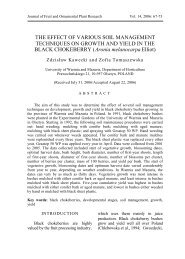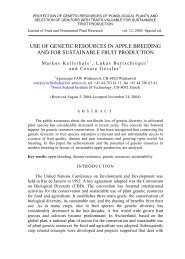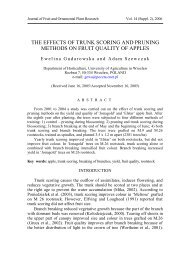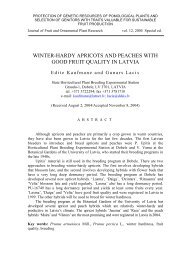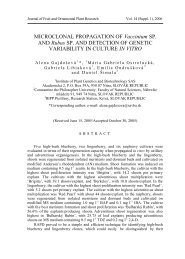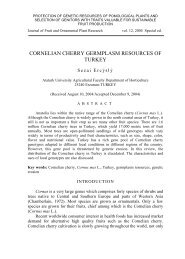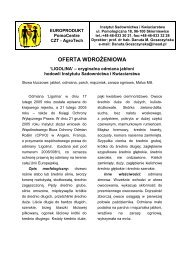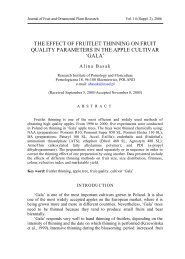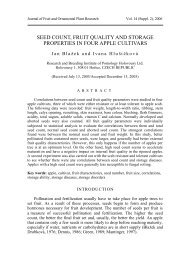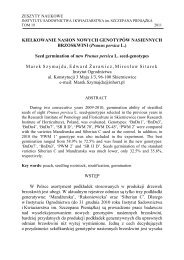productivity and fruit quality of scab resistant apple cultivars and ...
productivity and fruit quality of scab resistant apple cultivars and ...
productivity and fruit quality of scab resistant apple cultivars and ...
- No tags were found...
You also want an ePaper? Increase the reach of your titles
YUMPU automatically turns print PDFs into web optimized ePapers that Google loves.
A. Sasnauskas et al.have been released, including ‘Auksis’, ‘Noris’, ‘Staris’ <strong>and</strong> ‘Aldas’. Themost successful <strong>of</strong> these is ‘Auksis’, which has become the most importantcultivar in Lithuania. The primary goals <strong>of</strong> our breeding work have been <strong>fruit</strong><strong>quality</strong>, yield <strong>and</strong> resistance to <strong>apple</strong> <strong>scab</strong>. Scab <strong>resistant</strong> <strong>cultivars</strong> allowgrowers to save on disease control costs, decrease environmentalcontamination associated with fungicide use, <strong>and</strong> meet consumer dem<strong>and</strong>s for<strong>apple</strong>s with lower amounts <strong>of</strong> pesticide residue (Kühn <strong>and</strong> Thybo, 2001).There is currently widespread resistance to using <strong>scab</strong> <strong>resistant</strong> <strong>cultivars</strong> inorganic <strong>apple</strong> production, even though they have great ecological <strong>and</strong>economic advantages. Apple growers undermine their credibility by plantingtrendy <strong>scab</strong> susceptible <strong>cultivars</strong> (Weibel <strong>and</strong> Leder, 2003).The objective <strong>of</strong> this study was to evaluate yield <strong>and</strong> <strong>fruit</strong> <strong>quality</strong> in new<strong>scab</strong> <strong>resistant</strong> <strong>apple</strong> <strong>cultivars</strong> <strong>and</strong> hybrids.MATERIAL AND METHODSFrom 1997 to 2004, six new <strong>apple</strong> hybrids <strong>and</strong> three st<strong>and</strong>ard <strong>cultivars</strong>were evaluated at the Lithuanian Institute <strong>of</strong> Horticulture.Temperature is the most important factor determining yield in <strong>apple</strong>s,especially minimal winter <strong>and</strong> spring temperatures. Late spring frosts in 1999,2000 <strong>and</strong> 2004 did a lot <strong>of</strong> damage to the developing blossoms. At thesetimes, the minimal air temperature above the ground dropped to -5 o C in theorchard.The following <strong>scab</strong> resistance hybrids were evaluated: ‘Skaistis’ (18307),‘Rudenis’ (18451), 18422, 18429, 18437 <strong>and</strong> 18501 (Katja x Prima). All weredeveloped at the Lithuanian Institute <strong>of</strong> Horticulture. They were compared tothe st<strong>and</strong>ard <strong>cultivars</strong> ‘Tellissaare’, ‘Prima’ <strong>and</strong> ‘Staris’.In the spring <strong>of</strong> 1997, trees were planted 4 x 2.5 m in twelve replicates <strong>of</strong>one tree each. Trees were trained as spindles. All trees were maintained inaccordance with st<strong>and</strong>ard procedures recommended for commercial orchards.Trees <strong>and</strong> <strong>fruit</strong>s were evaluated in accordance with UPOV Test Guidelines(2005). Carotenoids <strong>and</strong> chlorophylls were recorded in mg/m 2 . Appearance,taste <strong>and</strong> <strong>quality</strong> were evaluated on a scale from 1 to 9.Data were elaborated by analysis <strong>of</strong> variance, followed by Fisher’sprotected LSD <strong>and</strong> Duncan’s multiple-range t-test at P=0.05.Blossoming <strong>of</strong> <strong>apple</strong> treesRESULTSApple trees <strong>of</strong> most varieties started blossoming in their second year inorchard. Blossoming was earliest in ‘Tellissaare’ <strong>and</strong> ‘Rudenis’ (May 5), <strong>and</strong>latest in ‘Staris’ (May 9). Full blossoming began earliest in ‘Rudenis’ (May8), <strong>and</strong> latest in Hybrid 18429 (May 17). Full blossoming ended earliest in‘Tellissaare’ <strong>and</strong> Hybrid 18437 (May 16), <strong>and</strong> latest in Hybrid 18429, Hybrid18501 <strong>and</strong> ‘Skaistis’ (May 19).248J. Fruit Ornam. Plant Res. vol. 14 (Suppl. 2), 2006: 247-255




